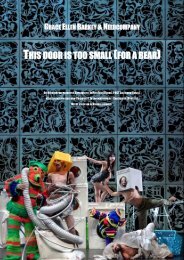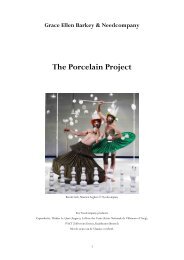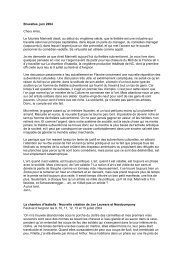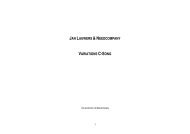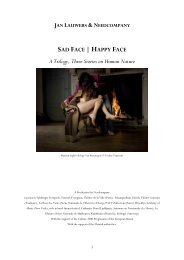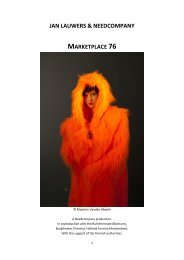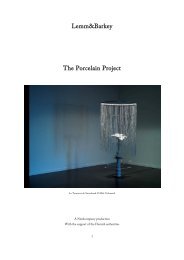THE ART OF ENTERTAINMENT - Needcompany
THE ART OF ENTERTAINMENT - Needcompany
THE ART OF ENTERTAINMENT - Needcompany
You also want an ePaper? Increase the reach of your titles
YUMPU automatically turns print PDFs into web optimized ePapers that Google loves.
and excitement that stimulate the nerves of the dead tired TV audiences day in and day out. But what<br />
exactly did we see? Did we see an image? Or were we already deep in the matrix of the obscene?<br />
4. Always look at the bright sides of death (2x)<br />
The main character in The art of entertainment, the latest play by Jan Lauwers, is Dirk Roofthooft. Dirk<br />
Roofthooft plays an ageing celebrity who has decided to put an end to his life. He is slowly losing his<br />
memory and his faculties and does not want to go through this process of degeneration: “I am no longer<br />
myself and it will not be long before I am no longer aware that I am no longer myself”. He is invited to kill<br />
himself in a reality show with a worldwide audience: The art of entertainment, the one and only real suicide<br />
show on the planet, with a global audience: “We have exceeded the 100 million viewer mark,” explains the<br />
moderator “and we hope to reach 110 million viewers tonight. The programme is broadcast in 74<br />
countries. Live… what a word for a programme in which someone is going to die. “ This reality show is also<br />
a cooking programme – perhaps the favourite TV format of the moment - in which a famous French chef<br />
prepares the last supper of the person about to commit suicide. While this last meal is being prepared, Dirk<br />
Roofthooft listens to his favourite music, the Stabat Mater of the prematurely deceased composer<br />
Pergolesi, and has conversations with several larger than life characters: Gena, his great, but unfaithful<br />
love; Doctor Joy, a doctor without borders, who will be present for the suicide; Liliane Van Muynck, the<br />
host of the show, a former stand-up comic making a come-back, etc. Their existential discussions that jump<br />
from one subject to another vacillate from acting, sex, art, politics, suicide; the favourite themes of a<br />
drifting intellectual class. There are also some grotesque characters who jump out from the margins of the<br />
story and interrupt it brutally with slapstick and inappropriate and obscene comments: Mr. Duchamp, a<br />
cook; James Brown, a washer up; Yoko, a piece of meat; a camera, etc. While Lauwers created a sort of<br />
‘community’ in his previous plays, however broken and fragmented it was, around the subject of sorrow<br />
and death, this time that is not the case. The TV studio does not allow for this apparently. There is no<br />
singing together either – the emotional trademark of the Sad Face | Happy Face trilogy – in this play: just a<br />
lot of chattering to fill in the time “because entertainment will not entertain the idea of a moment of<br />
silence”, the hostess of the programme tells us. No tragic generosity as we find in Isabella’s room, no<br />
collective mourning that we find in The Deer House. This time, Lauwers goes for Monty Python style<br />
comedy: absurd, black, sharp, incisive, at times insolent and even in poor taste.<br />
5. The Duchamp Fountain 1<br />
When Gena is about to be caught by Dirk in flagrante delicto with Dr. Joy, she rushes to sit down at table<br />
with the complete works of Rimbaud and pretends to read. Dirk subtly points out that she is holding the<br />
book upside down. Gena: “Oh, I wanted to see if I could find another meaning to Rimbaud’s Une saison en<br />
Enfer if you turned it on its head. Certain things are impressive when turned on their head.” What Gena is<br />
doing, is what modern art does with Beauty: turning it on its head. In the opening poem of Une saison en<br />
Enfer (1873) Rimbaud writes the well-known lines: “One evening I sat Beauty on my knees. And I found her<br />
bitter. And I insulted her.” In the last poem he writes an even more famous line: “One must be absolutely<br />
modern.” The first rule of modernity is to insult and to scorn Beauty. Modern art turns the rules of<br />
harmony, recognition, representation, order, tradition, history, work taste, emotion on their head to see if<br />
we can find “another meaning.” “Turning something on its head”, is the radical gesture of modern art and<br />
this is particularly true of the avant-garde. If there is a work of art that has not just articulated this gesture<br />
in all its clarity, but that has taken on the full responsibility for it – and has made art irremediably<br />
‘absolutely modern’, - it is Fountain (1917). It was under this English title, an exponent of traditional<br />
8




